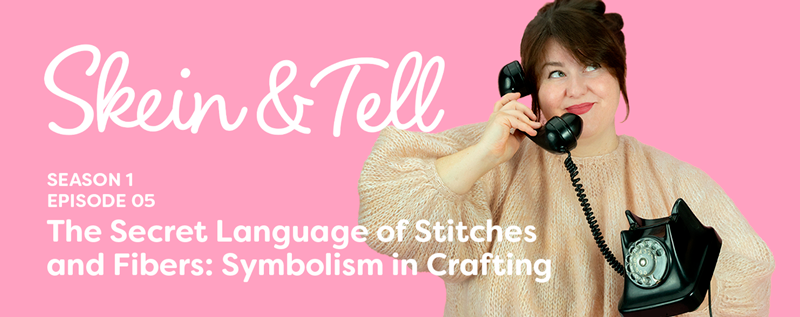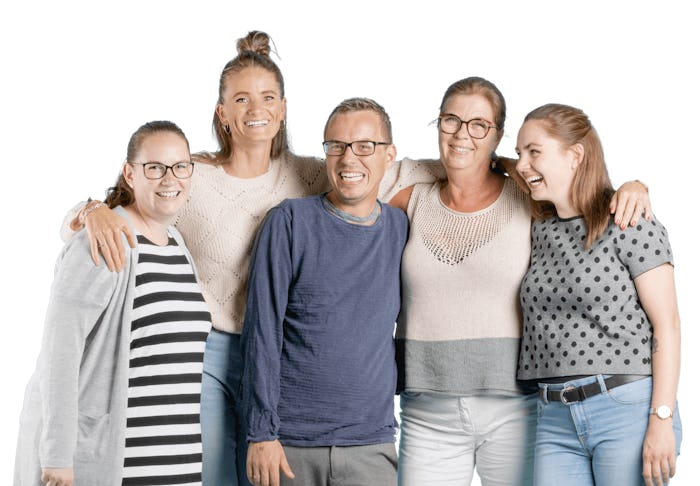Whether you're a beginner with your first ball of yarn or a seasoned stitch wizard, this episode will change how you see your projects. Every handmade piece carries meaning, sometimes hidden, sometimes loud, and Skein and Tell helps you unlock that deeper creative magic.

Welcome to episode 5 of Skein and Tell, Hobbii’s official podcast, where yarn lovers unite to explore all things fiber, community, and creativity. 🧶
In this episode, host Gea takes us on a magical journey into the hidden meanings woven into every stitch, loop, and knot. From ancient cultures to today’s cozy living rooms, fiber arts have always told powerful, silent stories, and this episode reveals how you can craft with more intention and purpose than ever before.
If you’ve ever wondered whether your stitches say something more than you realize, this one’s for you. ✨
Listen to Skein and Tell Episode 5 Now
Ready to hear it all straight from Gea? 🎙️ Press play, or scroll down to read the full transcript below.
Choose Where to Listen:
Here's what you'll learn in this episode:
🧵 (1:14) - How stitch patterns like garter, lace, and seed stitch symbolize comfort, love, protection, and growth—and how ancient cultures used textiles as a secret language.
☕ (3:18) - Weird Yarn Monday: Dive into the world of coffee yarn! Discover how recycled coffee grounds are turning into sustainable, odor-fighting yarn.
🧶 (4:56) - The deep symbolism hidden in knitting stitches like garter stitch, lace patterns, seed stitch, cable stitch, and ribbing—and how each one tells a unique story.
📈 (8:43) - What's Trending: Why yarn stashing is booming right now and why hoarding skeins is actually smart (and therapeutic!).
🧵 (12:25) - Crochet symbolism unlocked: Granny squares, shell stitches, and puff stitches—what they represent and why they’re perfect for heartfelt projects.
🎨 (15:52) - How colors like red, blue, and green amplify the emotional message behind your handmade pieces.
✨ (17:56) - How to craft with intention: Transform every project into a meaningful story by thoughtfully choosing your stitches, patterns, and colors.
So grab your WIP, cozy up with a cup of tea or coffee, and join us as we dive into the magical world of how wool is turned into yarn!
Can’t tune in right now? Catch everything Gea covers in the episode below.
Want More? Read the Entire Episode
Below is an edited transcript from Episode 5: Language of Stitches and Fibers - Symbolism in Crafting, originally presented on the Skein and Tell podcast.
Introduction
Gea: Hey yarn bestie, Gea here! Welcome back to Skein and Tell! Today we're diving into a topic that's as deep and intricate as the most perfect lacy pattern you've ever seen. We're talking about the secret language of stitches, yes, the hidden meanings and symbolisms behind every knot, twist, and loop you create with your knitting needles and crochet hooks.
History of Stitch Symbolism
Tune in at 1:14.
Gea: Before we dive into specific stitches, let's zoom out a little and talk about the history. Because believe it or not, people have been using textiles – knitting, weaving, crochet – not just to make stuff, but to say stuff. These crafts have been forms of communication for centuries.
Let’s start with Victorian England. This is where things get extra poetic. You might've heard of the "language of flowers," right? Well, the Victorians extended that into their textiles. Colors, patterns, even motifs in embroidery and cross-stitch, each element could represent a feeling, a belief, a secret message.
So, for example, stitching a violet might mean loyalty. A red rose? Love. These motifs would show up on handkerchiefs, pillowcases, table linens, like little embroidered messages.
And it wasn’t just Europe. In Native American cultures, different stitch patterns and beadwork designs told entire ancestral stories. Think about it: every bead, every line, held history. These patterns could mark births, marriages, rites of passage, or status in a tribe.
In fact, textiles were often used to document life events. Before we had journals or social media, people were literally stitching their stories. That cross-stitch sampler? Might actually be a family tree. A woven pattern? Could represent the lineage of an entire community.
So yeah, the language of stitches isn't just a metaphor. It’s a literal language. One that spans cultures and centuries, and that makes what we do with yarn so much more powerful.
Weird Yarn Monday: Coffee Yarn
Tune in at 3:18.
Gea: Today on Weird Yarn Monday, we’re talking about a fiber that fuels both your projects and your caffeine addiction: coffee yarn. Someone looked at used coffee grounds and thought, “This needs to be a sweater.” And honestly, they were right.
Coffee-infused yarn is usually made by blending coffee grounds with synthetic fibers like polyester or natural ones like cotton. The coffee grounds are processed into microscopic particles and embedded into the yarn fibers. The result? Yarn that actually benefits from coffee’s natural properties.
One of the coolest features is odor control. Coffee’s natural ability to absorb smells helps the yarn stay fresh. It's also got quick-drying qualities and UV protection – yup, like a sunscreen sweater. Some runners even use coffee yarn in their gear because it wicks moisture and blocks odor.
But for us yarn lovers, coffee yarn is a conversation starter. It’s sustainable too, since it makes use of recycled coffee grounds that would otherwise end up in landfills. So your next pair of mittens? They could be warm, cozy, and a little eco-conscious.
Also, can we talk about the color? It’s usually a rich, earthy brown that just screams “cozy fall vibes.” Makes you want to curl up with a latte and your WIP, doesn’t it?
I’m just saying, bestie, coffee yarn is the perfect blend of sustainability, function, and full-on fiber nerd magic.
Symbolism in Knitting Stitches
Tune in at 4:56.
Gea: Alright, let’s talk about symbolism in knitting stitches, and how each one can carry a hidden message in your handmade piece.
The garter stitch –knit every row – is one of the most basic stitches, but it’s packed with meaning. It represents comfort, stability, and patience. It’s the go-to for baby blankets, prayer shawls, and anything made to soothe. The texture is simple and strong, just like the steady love and care it often symbolizes.
Next up, lace knitting. It’s all about open spaces, delicate structure, and intricate design. Lace patterns often include holes created by yarn overs, symbolizing vulnerability, transparency, and emotional expression. It’s a favorite for wedding shawls or gifts during major life transitions, moments when emotions run deep and beauty is found in openness.
Now, let’s talk about the seed stitch. This stitch alternates knit and purl stitches, creating a bumpy, textured fabric that feels full of potential. Just like its name, the seed stitch symbolizes growth, hope, and new beginnings. It's perfect for anything you're gifting to someone starting a new chapter, maybe a graduation gift, baby item, or recovery blanket.
Let’s not forget the cable stitch, those beautiful twists and turns. They can represent connection, strength, and life’s journey. Think of them like a braid of intentions, or even the DNA of a story passed down through generations. They’re often used in heirloom sweaters for a reason, they carry the idea of continuity.
And finally, ribbing. It’s the unsung hero of structure, right? That stretchy, snappy border that keeps everything in place. It symbolizes resilience and balance. Ribbing pulls things together, it’s the friend who shows up when things start unraveling.
So next time you’re picking out a pattern, ask yourself, what do you want this project to say? Because every stitch speaks, and it’s your voice behind it.
What’s Trending
Tune in at 8:43.
Gea: Alright, besties, let's dive into what's hot in the yarn world right now.
First up, yarn stashing is making a comeback. Minimalism? That's so last year. Crafters are turning their closets and spare rooms into yarn havens. It's not just about hoarding; it's about being prepared. With supply chain uncertainties and rising costs, having a well-stocked stash is like having a safety net for your creativity.
But it's not just about quantity; it's about sustainability. Many are embracing the idea of 'stash-busting', using what they have before buying more. It's a win-win: you save money and reduce waste. Plus, rediscovering forgotten skeins can spark new project ideas.
And let's talk about the community aspect. Online forums and social media groups are buzzing with crafters sharing their stash-busting projects and tips. It's inspiring to see how creativity thrives when we challenge ourselves to use what's on hand.
So, whether you're building your stash or busting it, remember: it's all about finding joy in the process and making the most of what you have.
Symbolism in Crochet Stitches
Tune in at 12:25.
Gea: Welcome back, bestie. Now let’s talk crochet symbolism.
The granny square, iconic, right? It represents community, family, and tradition. Every square is a small part of a bigger whole, symbolizing togetherness and lasting legacy. That’s why so many heirloom blankets are made from granny squares, each one is a building block of memory.
Then there’s the shell stitch. It’s made with half double crochets in a single stitch, and it’s a symbol of protection and strength. Think of an actual shell, shielding what’s inside. It’s a beautiful choice for shawls, wraps, or anything meant to comfort and protect someone, whether physically or emotionally.
And let’s not forget the puff stitch. This one’s all about deep emotion and love. The fullness of the stitch, the way it stands out in the fabric, it symbolizes abundance and heartfelt affection. It’s often used in baby blankets and heartfelt gifts because it says, “I made this with so much love.”
So when you’re working your next project, think about what story you’re telling. Each stitch is more than just technique, it’s a piece of emotion, a piece of intention, woven right in.
Color Symbolism in Yarn
Tune in at 15:52.
Gea: Now while we’re talking symbolism, let’s talk color. Because color is powerful too.
Red? That’s passion, energy, love. Think romantic gifts or projects that need a bold statement.
Blue brings calm, healing, and trust. A blue shawl or pillow could bring peace into a stressful space.
Green is growth, balance, and prosperity. A green blanket or bag might represent a fresh start or healing.
Crafting with Intention
Tune in at 17:56.
Gea: Now that we’ve unlocked the secret meanings behind stitches –and even color – let’s think about how we can incorporate this into future projects.
Crafting with intention is powerful. Even if the recipient doesn’t know the symbolism, sharing it makes your gift even more meaningful.
So if you’re creating something for comfort, maybe use darker yarn in garter stitch. Or if you're celebrating someone, go for a bright yarn in puff stitch to symbolize abundance and joy.
The secret language of stitches is more than aesthetics. It’s a silent story, a message from your hands to someone’s heart.
So next time you pick up your needles or your hook, think about what you want to say.
Thanks for hanging out with me today, bestie. Keep stitching with purpose, and keep telling your story through yarn.
Love you. Until next time, bye!
Ready for Next Episode?
Check out our next two episodes:
Skein and Tell Ep. 6: The Psychology of Stitching and Why Our Brains Love Repetition
Skein and Tell Ep. 7: Yarn Weights Decoded - Choose the Right Yarn and Substitute like a Pro
Psst! Don’t forget to send your stories to [email protected].
